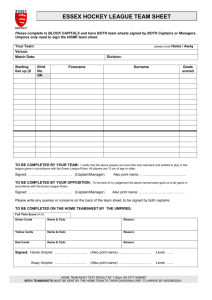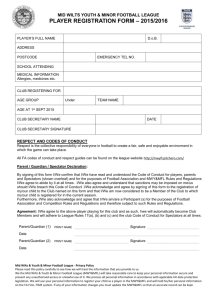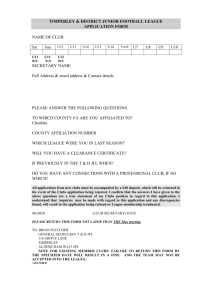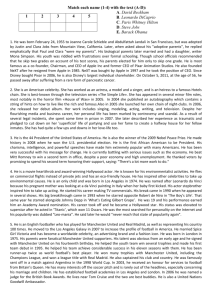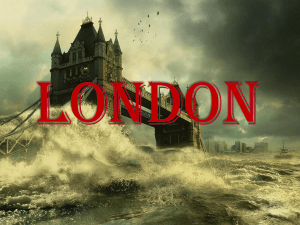Why is Manchester United So Successful?
advertisement
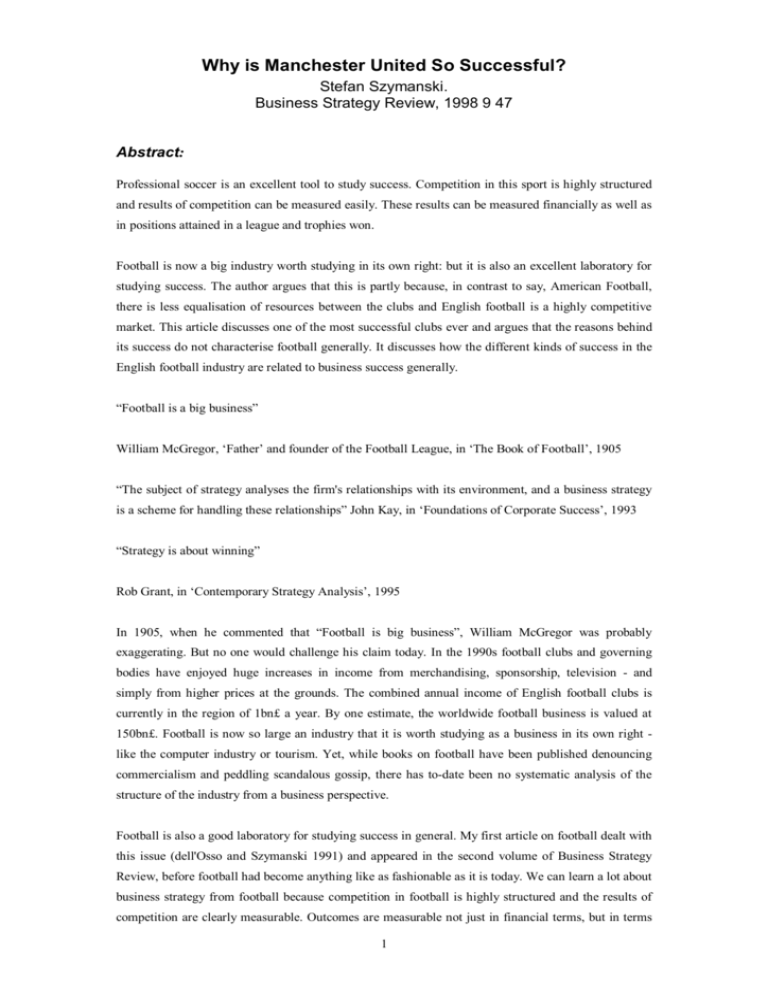
Why is Manchester United So Successful? Stefan Szymanski. Business Strategy Review, 1998 9 47 Abstract: Professional soccer is an excellent tool to study success. Competition in this sport is highly structured and results of competition can be measured easily. These results can be measured financially as well as in positions attained in a league and trophies won. Football is now a big industry worth studying in its own right: but it is also an excellent laboratory for studying success. The author argues that this is partly because, in contrast to say, American Football, there is less equalisation of resources between the clubs and English football is a highly competitive market. This article discusses one of the most successful clubs ever and argues that the reasons behind its success do not characterise football generally. It discusses how the different kinds of success in the English football industry are related to business success generally. “Football is a big business” William McGregor, ‘Father’ and founder of the Football League, in ‘The Book of Football’, 1905 “The subject of strategy analyses the firm's relationships with its environment, and a business strategy is a scheme for handling these relationships” John Kay, in ‘Foundations of Corporate Success’, 1993 “Strategy is about winning” Rob Grant, in ‘Contemporary Strategy Analysis’, 1995 In 1905, when he commented that “Football is big business”, William McGregor was probably exaggerating. But no one would challenge his claim today. In the 1990s football clubs and governing bodies have enjoyed huge increases in income from merchandising, sponsorship, television - and simply from higher prices at the grounds. The combined annual income of English football clubs is currently in the region of 1bn£ a year. By one estimate, the worldwide football business is valued at 150bn£. Football is now so large an industry that it is worth studying as a business in its own right like the computer industry or tourism. Yet, while books on football have been published denouncing commercialism and peddling scandalous gossip, there has to-date been no systematic analysis of the structure of the industry from a business perspective. Football is also a good laboratory for studying success in general. My first article on football dealt with this issue (dell'Osso and Szymanski 1991) and appeared in the second volume of Business Strategy Review, before football had become anything like as fashionable as it is today. We can learn a lot about business strategy from football because competition in football is highly structured and the results of competition are clearly measurable. Outcomes are measurable not just in financial terms, but in terms 1 of success on the pitch, through games won and lost, league positions achieved and trophies won. Few other industries produce such clear indicators of who are the winners and who are the losers. In the 1990s Manchester United has been the most successful English football club. Since the foundation of the Premier League in 1992 it has won four of the six titles and been runner-up on the other two occasions. It has won the FA Cup twice and been runner-up once. Only in Europe has success eluded the club - it has failed to win the European Cup/ Champions League in five attempts so far. Manchester United has also been the most successful club financially. Between 1992 and 1997 the club generated income of 249m£, of which 69m£ was spent on its wage bill and 66m£ reported as profit. This performance would be a good by any standard; in the football industry, where most clubs have reported a pre-tax loss, it has been dazzling. For this reason some commentators have suggested that broadcaster BSkyB's offer of 624m£ to buy the club in September 1998 can be justified on financial performance alone, rather than any particular interest in the broadcast rights. Profits, Performance and the Market What makes Manchester United's success interesting from a business perspective is that it has managed to make money while winning. It might seem obvious that financial success and success on the pitch go together. In fact, there is no systematic relationship between the two. Table 1 illustrates this. In our forthcoming book (Szymanski and Kuypers 1999) we have assembled a large database of financial statistics relating to football clubs over the past one hundred years by examining publicly available accounting data. Table 1 is based on the reported annual pre-tax profit of forty clubs over a twenty-year period: there are 760 cases where from one year to the next we can compare the change in profit to the change in league position. Table 1 Co-movements in profits and league position in a given year Change in current year league position Change in current Year profits Up Down Up Down 27% 25% 22% 27% If above-average league performance always led to higher profits we would find that about that half of the clubs whose league position rose would also show increased profits (the top left-hand box in table 1) while for the other half of clubs, league position would fall and profits would fall (the bottom righthand box). The other two boxes (top-right and bottom-left) would be empty. What we actually find is that club results fall into each of the four boxes in roughly equal proportions. In other words, it appears just as likely that when league performance improves, profits will fall as that they will rise, while when league performance deteriorates, it is more-or-less equally likely that profits will rise or fall. There appears to be no systematic relationship between profits and league performance. This finding is confirmed if we look at other ways of examining the data, for example comparing the change in profits in the current year with the change in league performance in the previous year. Why should this be? 2 Profit, of course, is simply the difference between revenue and cost. If we now consider the relationship between revenues and performance on the one hand and performance and costs on the other, a much clearer picture emerges. In fact, we can state two general principles based on our research: • Better league performance leads to higher revenue • Increased wage expenditure leads to better league performance. These two fundamental relationships show the relationship between revenue and league position. As club performance improves, revenues grow as a result of increased attendance, higher ticket prices, increased sponsorship, merchandising and TV income. In fact, 82% of the variation in revenue between the clubs in 1996/97 could be explained simply by league position. The same relationship can be found when we look at the performance of clubs over time: higher revenues flow from higher league positions. How higher wage expenditure by clubs leads to higher league positions. The total wage bill of the club measures wage expenditure, but most of this expenditure is dominated by player wages. These fundamental relationships hold because of the operation of markets: better players win more matches. There is a well-developed market for players that ensure that better-quality players can attract higher wages. As a result, higher wage expenditure improves performance. Similarly, there is a market for success. At the margin, fans and sponsors are attracted by success: so better performance attracts higher income. The reason that these two relationships are so reliable is that, in the absence of significant redistribution of income, football is a highly competitive market. While all the clubs are dependent on each other to produce matches, at the same time they compete intensively against each other to attract supporters and to obtain the best players. Unlike rival sports such as baseball, American Football or basketball, football leagues do very little to redistribute income to create a balanced competition. As a result, bigger clubs may be valued more highly by the stock market, but successful clubs cannot in general sit back and harvest profits. Profits are always ploughed back into the team in order to preserve the competitiveness of the club. Except, of course, in the case of Manchester United. How Manchester United Bucked the Trend Manchester United has always been controversial. The club entered the Football League in 1892 and was almost bankrupted in 1902. Primarily a wealthy local brewer, J.H. Davies, saved it. He had ambitions to create a major footballing power and invested heavily, particularly in the development of the ground at Old Trafford. From its completion in 1910, this became one of the leading stadia in the country, perhaps the most important stadium in the north of England, hosting Football Association (FA) Cup semi-finals and final replays from its earliest years down to the present. Under Davies, the 3 club became known as “moneybags United” and was officially censured by the League and the FA in 1910 for misrepresenting its financial statements. The club enjoyed League and Cup success in this era, winning the First Division Championship in 1908 and 1911 and the FA Cup in 1909. Between the wars, the club sank into relative obscurity, moving between the First and Second Divisions and failing to win any honours. During the Second World War, Old Trafford was badly damaged by German bombing raids and after the War the club faced a crisis. Apart from rebuilding a team, the club needed to rebuild its stadium. The directors gambled in appointing as manager a leading pre-war player, Matt Busby. He achieved almost immediate success by winning the FA Cup in 1948 and his team were runners up in the First Division on three occasions in the late 1940s. Success enabled the home ground at Old Trafford to be rebuilt by 1949 and finally Busby's team won the League in 1952. Busby also made it “his” club. From the very beginning he insisted on management control, an unusual situation at a time when it was normal for the directors to select the team and decide upon transfers. Before the War, managers were generally more like trainers. A football club resembled a military unit, players taking orders without question from the manager, who in turn received orders from the directors. Busby started the long process of breaking down this antiquated approach to management, and took revolutionary steps such as consulting the team about decisions, asking their opinions generally, and insisting that it was the management - not the directors - who were best placed to make footballing decisions. After winning the Championship, Busby had to rebuild his team with younger players. The Busby Babes, as they were known, were an outstanding collection of young talent and won the League in 1956 and 1957, a remarkable achievement for a team of players mostly in their early twenties. Manchester United was the first English club to enter the newly created European Cup. It was defeated in the semi-finals at its first attempt in 1957 and then in 1958 reached the semi-finals again. It beat Red Star Belgrade over two legs, 2-1 at home and then 3-3 in Belgrade on February 5th 1958. On the return flight the next day the plane stopped to refuel at Munich. Trying to take off in a blizzard, the plane crashed, killing eight of the young squad, which would probably have dominated English football for the decade. Fifteen others died in the crash, and Busby himself was severely injured and only just survived. The tragedy shocked fans and nonfans alike, not just in England but throughout the world. Without question, it changed the attitude of many towards the club and certainly made it a household name. From this time on, Manchester United became one of the best-supported clubs in the country. Busby recovered, and went on to lead the club to its greatest triumph, the European Cup victory of 1968. The squad of 1968 contained some of the club's greatest stars: Bobby Charlton, George Best and Denis Law. By then, Manchester United had become a team of expensive superstars. In the 1950s Busby had built great teams from a limited budget; but in the 1960s he had the luxury of being able to spend money on acquiring talent - and he did so. This latter period coincided with the abolition of the maximum wage and the relaxation of controls over player transfers, which inaugurated the era of skyrocketing player wages. 4 After Busby gave up the job of manager in 1971 the club experimented with a series of managers but enjoyed little playing success over the next twenty years. This was the Liverpool era. Over this period Liverpool won 11 League titles, was runner-up six times, won the FA Cup three times and was runnerup twice, won the European Cup four times and was runner-up once and won the UEFA Cup twice. This was a sustained and unprecedented dominance of English football by one club. And yet, despite not winning a League title or European competition over the period, Manchester United remained a much better supported club than any other did, including Liverpool. Table 2 compares the ranks of Liverpool and Manchester United in terms of league position and attendance at league matches. Table 2 Manchester United and Liverpool: Comparison of League Position and League Attendances 1972-1990 Year Liverpool average league gate (`000s) Rank in Football League of attendances Liverpool League position Manchester United average league gate (`000s) 1972 1973 1974 1975 1976 1977 1978 1979 1980 1981 1982 1983 1984 1985 1986 1987 1988 1989 1990 48 48 42 46 42 47 46 46 45 38 35 35 32 34 35 36 40 39 37 1 2 2 2 2 2 2 2 2 2 3 2 2 2 2 2 1 1 2 3 1 2 2 1 1 2 1 1 5 1 1 1 2 1 2 1 2 1 46 49 43 48 55 54 52 46 52 45 45 42 43 43 46 41 39 36 39 5 Year Rank in Football League attendances Manchester United League position 1972 1973 1974 1975 1976 1977 1978 1979 1980 1981 1982 1983 1984 1985 1986 1987 1988 1989 1990 2 1 1 1 1 1 1 1 1 1 1 1 1 1 1 1 2 2 1 8 18 21 23 3 6 10 9 2 8 3 3 4 4 4 11 2 11 14 Ratio of Manchester United to Liverpool's attendances (%) 96 101 101 105 132 114 114 100 116 120 127 120 133 124 131 112 99 94 107 This support was critical to the long-term survival and prominence of the club. Whilst it is true that Manchester United continued to play attractive football throughout its relatively lean years, this alone cannot account for the sustained interest in the club. Manchester United resembles brands like Coca-Cola, Marlboro cigarettes or Nescafe. Although they compete in markets crowded with superficially similar products, consumers have a strong tendency to rely on their established brand image in preference to their rivals. There are any number of cola drinks or cigarette brands in the world: indeed, in a blind taste test, consumers may be unable to distinguish a cola drink from genuine Coca-Cola, or Marlboro tobacco from any other brand. But the established brand names can still sell at higher prices than rivals and continue to dominate the market. In a sense, this is what Manchester United achieved: despite a lower level of League performance than its major rivals, it was still able to attract more customers than these clubs. It is quite rational for consumers to make choices based on brand image, even if they pay higher prices for the same product. First, choosing a brand name is generally simpler than choosing from a range of similar products in a world where it is costly to acquire information. If consumers had adequate information, they might choose to buy a better-value brand of coffee each week, or choose to see a different football match. However, information processing is very costly: so it makes sense to go and see a team with an established track record. Few clubs in post-war England have had a better track record than Manchester United, even if this argument was beginning to wear a bit thin by the early 1990s. Second, choosing a brand name is often a safer decision than gambling on a less well known alternative choice. Brand names represent a long history of product development and promotion. The owners of a strong brand have a big incentive to try to maintain that image, while owners of products without such an image have less to worry about if they let the customer down. In that sense, just as Nescafe will 6 always be committed to maintaining the quality of its coffee, Manchester United will always be committed to attractive match-winning football: to stop doing so would be to throw away a valuable image built up over many years. To fans considering the choice of club to support over a lifetime, this is a comforting thought. Third, given that many people choose to support their local team, people who choose a non-local team are to some extent exceptional, and are clearly making a choice based on different criteria. One criterion for such a choice is likely to be history and image. Finally, given that for most supporters there is usually a fairly large number of local teams to choose from, the actual choice of club can be a fairly random decision based on experiences early in one's youth. A decision such as this is likely to be influenced by the most popular team around at any point in time. To some extent, Manchester United is well supported because it has always been well supported. The ultimate consequence of Manchester United's reputation was the ability to sustain itself through the lean years. By 1992 the club had gone 25 years without a League Championship. In a similar position, most other clubs would have suffered financially. Manchester United, however, was still able to spend large sums on wages and, when required, transfers. Of course, brands can lose their value if their image fades, and arguably Manchester United's image was beginning to tarnish by the early 1990s. To understand how it got back to winning ways it is necessary to look back into the financial history of the club. The Edwards family from the early 1960s controlled Manchester United Ltd. Louis Edwards, a Manchester meat-trader, was an acquaintance of Matt Busby at the time when he was looking for supportive businessmen to steer the club in a way sympathetic to his own philosophy. Edwards was elected to the Board in 1958 and became Chairman in 1962, owning 17 of 4,132 shares in the company. He then set out to own the company. He went through the register of shareholders and approached them one by one with an offer to buy their shares. By 1964, he held a controlling interest in Manchester United Ltd. His son Martin became Chief Executive of the club in 1981. Martin Edwards appeared to have always wanted to make money from United and over the years he searched for ways to realise the value of some of his father's investment. In 1986, the club sacked Ron Atkinson as manager and appointed Alex Ferguson. Ferguson had been one of the most successful managers in the history of Scottish football, turning Aberdeen into a serious rival to the long-dominant clubs of Celtic and Rangers. In his first full season at Manchester United the club came second in the League, better than anything it had achieved under Atkinson. However, in the years that followed things did not go so well. It is possible to understand what happened at United by looking at the accounting data for the first two full (financial) years of Ferguson's tenure. Table 3 presents the key financial statistics of Manchester United in the financial years 1987/88 and 1988/89. Income at the time was rising, there being a particularly healthy increase in income from commercial activities such as conferences held at the club's facilities. Financially, the main difference between the two years is the substantial drop in 7 transfer spending, from 2.5m£ to a mere 19,000£. Combined with the rise in income, this led to a 3m£ change in profits, from a 930,000£ loss to a healthy-looking profit of 2,079,000£. Table 3 Manchester United: League Position And Profits 1987-1989 Change League position Revenue 000£ Football Commercial activities Catering year on year (%) 87/88 88/89 2 11 -9 7,577 4,775 2,092 730 9,441 5,222 3,445 774 +25 +9 +65 +6 2,448 2,496 2,909 19 +19 -99 3,563 4434 +24 -930 2,079 +3,009 Expenditure 000£ Wages Transfer spending Other (mostly operating charges) Pre-tax profit 000£ But this also meant that total spending on players fell from 4.9m£ to 2.9m£. At the time the club needed to rebuild its squad following the departure of Atkinson. In fact, the main transfer expenditure of 1987/8 had been 1.6m£ for Mark Hughes who was returning to United after two years at Barcelona. Atkinson had bought 19 players between 1982/3 and 1986 and had sold four. Ferguson sold twelve club players in his first four years in charge - the only player to survive longer was the club captain, Bryan Robson. Although Ferguson has paid a lot of attention to developing a youth policy to grow talent in-house, the only significant homegrown player to come through by then had been Ryan Giggs. Given that Alex Ferguson sold most of the players bought by Atkinson in the previous five years, United was clearly in need of some new blood. However, at the time, the profit-conscious board of directors, led by Martin Edwards, was unwilling to sanction the level of spending that Ferguson had expected when he came to the club. Interviews from the time illustrate his frustration: “I came here thinking I would have the luxury of buying players. I have done a lot of hard work at youth levels but to win the League we need to buy. I'm disappointed I haven't had that kind of money. Liverpool has bought the best and what sticks in my gullet is the difference between “them and us”. He (Martin Edwards) is now facing two very tough choices between having a very good team and balancing the books” (Crick and Smith 1989). An illustration of the financial straightjacket Ferguson found himself in came in the summer of 1988 when he tried to sign Paul Gascoigne but was refused permission by Edwards. Things changed in the summer of 1989. Between July and September Ferguson was allowed to go on a spending spree. He bought five players: Gary Pallister, Neil Webb, Paul Ince, Mike Phelan and Danny Wallace for somewhere in the region of 8m£, an astronomical outlay for the time. That season the club spent 5.2m£ net on transfer fees. Why the change of heart? 8 The simplest explanation is that Edwards had decided to sell the company. Having already found a buyer and struck a deal, in May Edwards felt obliged to deny that he was interested in selling the club, so strong were the rumours that he was trying to do so. Yet on August 18th it was announced that Michael Knighton would buy the club for 20m£. Ironically, the bid fell through in October because Knighton could not raise the money, but not before Ferguson had been able to complete his purchases. Despite having signed a new three-year contract in September, Ferguson was clearly under pressure to prove that he could achieve something after all this expenditure. The season did not start particularly well. A 5-1 defeat by Manchester City was followed by a string of draws in the League and it was widely said that Ferguson would have been fired had they lost a third round FA Cup-tie against Nottingham Forest in January 1990. By February the club was falling into the relegation zone and only continued participation in the FA Cup stopped the pressures mounting further. In the end, the club managed to finish only 13th in the League that season. However, none of that mattered because Ferguson finally won the club a trophy, if only just: drawn away from home in every round, the club won the 1990 FA Cup against Crystal Palace in a replay after a 3-3 draw. (United was actually 3-2 down in extra time - had the match been lost, it seems unlikely that Ferguson would have survived another season.) From this point onward, Manchester United returned to winning habits, and Ferguson's position was secure: the club won the European Cup Winners' Cup in 1991, the League Cup in 1992, and - most important of all - the inaugural Premier League Championship in 1993; it then won four of the first five Premier League Championships as well as two more FA Cups. It was the transfer spending in the summer of 1989 that marked the watershed for the club, in particular the acquisitions of Pallister and Ince, who formed the backbone of the team over the coming years. While Ferguson had wanted to buy in the market for some time, it seems that it was only the miscalculations of the Knighton takeover bid that freed him from the financial constraints. Conclusions Any business can succeed if it is monopoly: the real lessons are to be learnt from those companies that manage to thrive in a competitive environment. Football is a useful example for business analysis since the competitive process can be demonstrated in a clear and striking way. In our forthcoming book, we have tried to explain just how companies can rise above competitive mass. As well as Manchester United; we look at cases such as Liverpool and the manager Brian Clough. Throughout, we set the performance of exceptional clubs and individuals in the context of the market and its operation. In Manchester United's case it seems fairly clear that its exceptional character is a consequence of its “brand image”, something which its rivals are unable to replicate. The problem for business strategy is that, while we can understand how Manchester United became successful, it is harder to explain how to copy it. The analysis shows that much of what explains Manchester United's success is contingent, driven by good and bad fortune, and hardly the outcome of a conscious strategic plan. Indeed, if there were a simple formula for imitating United then its ability to make high profits would be eroded as well. 9 In the process of succeeding, Manchester United has contributed to the transformation of football. Its flotation in 1991 has been a model for other clubs, most of that have been able to tap the market largely because of United's success. Manchester United was in the forefront of leading the breakaway of the top clubs from the Football League in 1992 to form the Premier League, largely with a view to retaining more of the TV money. It has also been a supporter of plans to create a European Superleague. In September 1998 BSkyB launched its bid to acquire the club. If this deal is ultimately approved following the Monopolies and Mergers Commission inquiry, it is expected that other media companies will follow suit. Whether or not Manchester United continues to be as successful in the next few decades, it will have left its mark on the football business. This article looks at a specific issue discussed in ‘Winners and Losers: the Business Strategy of Football’ by Stefan Szymanski and Tim Kuypers, to be published in April 1999. Stefan Szymanski is a Lecturer in Economics at Imperial College Management School, London References Crick and Smith (1989) Manchester United: Betrayal of a Legend Pelham Books dell 'Osso, F. and Szymanski, S. (1991) Who are the Champions? An Analysis of Football and Architecture Business Strategy Review, Volume 2, 2 Szymanski, S. and T. Kuypers (forthcoming, 1999) Winners and Losers: the Business Strategy of Football Penguin UK 10 Statistical Analysis Descriptive Statistics Variable Liverpl Manchstr gate_diff N 19 19 19 Mean 40.58 45.47 4.89 Median 40.00 45.00 6.00 TrMean 40.65 45.47 4.88 Variable Liverpl Manchstr gate_diff Minimum 32.00 36.00 -3.00 Maximum 48.00 55.00 13.00 Q1 35.00 42.00 1.00 Q3 46.00 49.00 9.00 StDev 5.36 5.23 4.82 SE Mean 1.23 1.20 1.11 Consider the data for Liverpool. Liverpl 50 40 30 1970 1980 1990 year Clearly the Liverpool gate shows a steady decline. What might be expected next year? Regression Analysis The regression equation is Liverpl = 1452 - 0.712 year Predictor Constant year Coef 1451.6 -0.7123 S = 3.658 StDev 303.5 0.1532 R-Sq = 56.0% T 4.78 -4.65 P 0.000 0.000 R-Sq(adj) = 53.4% Analysis of Variance Source Regression Residual Error Total DF 1 17 18 SS 289.19 227.45 516.63 MS 289.19 13.38 F 21.61 P 0.000 Predicted Values Fit 33.456 StDev Fit 1.747 ( 95.0% CI 29.771, 37.142) ( 95.0% PI 24.904, 42.008) The relatively high value for the variance is reflected in quite a wide interval for the estimated value. Consider the data for Manchester. 11 Manchstr 55 45 35 1970 1980 1990 year Clearly the Manchester gate shows a steady decline. What might be expected next year? Regression Analysis The regression equation is Manchstr = 1324 - 0.646 year Predictor Constant year Coef 1324.4 -0.6456 S = 3.874 StDev 321.5 0.1623 R-Sq = 48.2% T 4.12 -3.98 P 0.001 0.001 R-Sq(adj) = 45.2% Analysis of Variance Source Regression Residual Error Total DF 1 17 18 SS 237.59 255.15 492.74 MS 237.59 15.01 F 15.83 P 0.001 Predicted Values Fit 39.018 StDev Fit 1.850 ( 95.0% CI 35.114, 42.921) ( 95.0% PI 29.960, 48.075) The relatively high value for the variance is reflected in quite a wide interval for the estimated value. An analysis of the gate difference may be attempted. 15 10 fd i_ e ta g 5 0 1970 1980 1990 year The gate difference appears independent of the year, although usually to Manchester’s advantage. While the plot gives a clear indication a prediction for the next year may be attempted. Regression Analysis The regression equation is gate_diff= - 127 + 0.067 year 12 Predictor Constant year Coef -127.2 0.0667 S = 4.942 StDev 410.1 0.2070 R-Sq = 0.6% T -0.31 0.32 P 0.760 0.751 R-Sq(adj) = 0.0% Analysis of Variance Source Regression Residual Error Total DF 1 17 18 SS 2.53 415.26 417.79 MS 2.53 24.43 F 0.10 P 0.751 Predicted Values Fit 5.56 StDev Fit 2.36 ( 95.0% CI 0.58, 10.54) 95.0% PI -5.99, 17.12) ( As expected the prediction is almost certainly positive, but could take almost any sensible value. Tests may now be performed comparing the two data sets. Two Sample T-Test and Confidence Interval Two sample T for Liverpl vs Manchstr Liverpl Manchstr N 19 19 Mean 40.58 45.47 StDev 5.36 5.23 SE Mean 1.2 1.2 95% CI for mu Liverpl - mu Manchstr: ( -8.4, -1.4) T-Test mu Liverpl = mu Manchstr (vs not =): T = -2.85 P = 0.0073 Mann-Whitney Confidence Interval and Test Liverpl N = 19 Median = 40.000 Manchstr N = 19 Median = 45.000 Point estimate for ETA1-ETA2 is -5.000 95.3 Percent CI for ETA1-ETA2 is (-9.000,-1.001) W = 290.0 Test of ETA1 = ETA2 vs ETA1 not = ETA2 is significant at 0.0195 The test is significant at 0.0191 (adjusted for ties) T-Test of the Mean Test of mu = 0.00 vs mu not = 0.00 Variable gate_diff N 19 Mean 4.89 StDev 4.82 SE Mean 1.11 T 4.43 not = 0.00000 P 0.0003 Sign Test for Median Sign test of median = 0.00000 versus gate_diff N 19 Below 3 Equal 1 Above 15 P 0.0075 Median 6.000 All point to the same conclusion, the data sets are not comparable. 13 DF = 35

